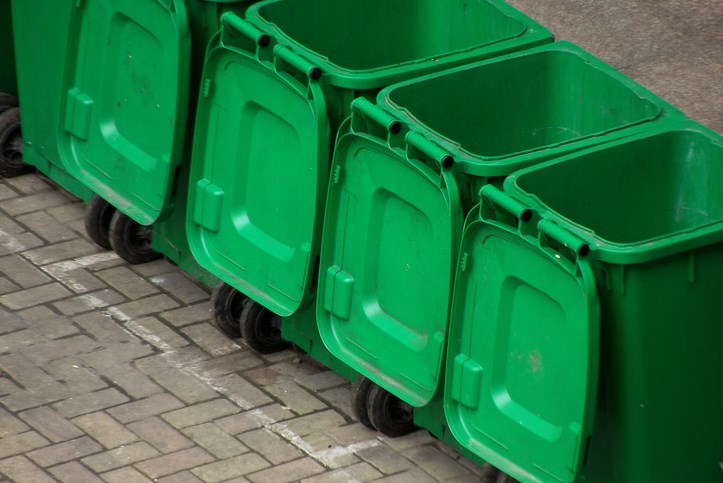The County of Simcoe deals with solid waste management in its 16 member municipalities, including Collingwood.
The county manages the weekly curbside collection of garbage, recycling and organics from approximately 148,000 residences, and the operation of landfill sites and transfer stations.
And, it has been doing its best to limit the amount of waste going to landfills, through diversion, recycling and composting, said Wilma Bureau, collections and contracts supervisor.
“The overall waste diversion rate in 2017 was 60.7 per cent,” said Bureau. “It’s actually the best in Ontario – but there’s definitely still room for improvement.”
Bureau noted a study of the garbage set out by residents found that “11 per cent of curbside garbage is recyclable – and 50 per cent is organics.”
Part of the problem may be that residents just aren’t clear on what can and can’t be recycled – what belongs in the green bin, the blue bin, and the trash can. Basically, the “etiquette of trash.”
Here are some guidelines:
Food cans and glass jars are recyclable. They should be “reasonably clean,” before being placed in the blue bin, said Bureau. “You don’t have to wash them – just no half-full peanut butter jars.”
Plastic pop and water bottles are recyclable. “You can leave the caps on,” said Bureau. As for the big debate, as to whether or not to flatten the bottles, she says leave them as they are: “Flattening certainly saves room in the truck, but most operational systems have equipment that separates three-dimensional from two-dimensional waste,” Bureau explained. It can also mistake flattened water bottles for paper products. “It ends up in the paper stream, where it shouldn’t be. Technology in the multi-material recycling facility has changed.”
Plastics labeled one through seven can be recycled in the blue bin. There is some important exceptions, notably black plastic. “Black plastic is a tough one,” said Bureau. “Our processor is not able to process black plastic,” since the technology used in the plant can’t distinguish between the black plastic and the black conveyor belt. “Brown is probably fine, like Tim Hortons coffee lids,” she said, noting that in the early days of recycling both the types of plastic and the amount collected were limited, and sorting was done by hand. “Now there’s way more different plastics, way more different grades – and it’s all done much more with technology.”
If the plastic doesn’t have a number or a recycling symbol, don’t put it in the blue bin. And certainly don’t try to recycle plastic hangers, garden furniture or non-food plastic packaging. Bureau calls it “wish cycling” to dump miscellaneous plastics in the recycling bin. “They put it in because they hope it’s recyclable. In the end, it can become a contaminant,” she said. And styrofoam is not recyclable in Simcoe County.
Plastic windshield washer fluid jugs can be recycled, as long as they are clean – but plastic oil containers are always household hazardous waste. It’s impossible to remove all traces of the oil.
Plastic film goes in the garbage. However, those plastic labels on large pop bottles can be left in place.
Aluminum foil can be recycled, as long as it’s “relatively clean,” said Bureau. “You don’t have to wash it, but you don’t want to take the whole top layer of cheese off your lasagna.” But foiled paper or metallic gift wrap goes in the trash.
Aerosol cans can be recycled “as long as they are empty,” Bureau said. If they aren’t empty, they should be treated as household hazardous waste and taken to landfill for safe disposal because they can explode under pressure.
Waxed cardboard – the kind used to transport fruit and other produce – is not recyclable. The wax keeps the cardboard from breaking down. Those “waxed” cartons used to hold milk or juice are recyclable, because they aren’t really waxed. “It’s aseptic packaging,” said Bureau. “The quality of paper in them is very high.” Leave the plastic caps on the cartons.
Organic waste goes in the green bin, not in the trash. That includes leftover food, meat, bones, coffee cups (minus the lids), napkins, paper towels, kitty litter and pet waste, in biodegradable bags. No plastics, litter tray liners, pee pads, or diapers.
Large plastic or cardboard drums and pails more than four litres in size? Trash. They’re too big for the bin.
Metal? If it isn’t a food can, cookie tin, jar lid or bottle cap, it should be taken to a transfer station to be disposed of as scrap metal. No metal hangers, paper clips, metal pail handles, shovels, car parts, etc. in the blue bin.
“Know before you throw,” said Bureau, inviting residents to check the County of Simcoe’s website and its Waste Wizard database before disposing of items. “If you’re not sure, check. Every municipality is different.”
See simcoe.ca/SolidWasteManagement for more details.



